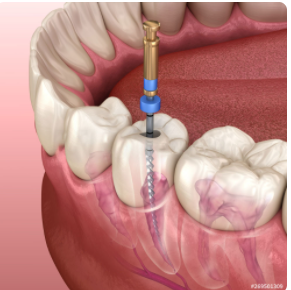Root canal treatment is a dental procedure that replaces a tooth’s damaged or infected pulp with a filling. The pulp is the tooth’s lifeline – its vessels, tissue fibres and nerves in the central hollow of the tooth keep it alive. The procedure to replace this damaged or infected pulp is also known as endodontic treatment.
Success rates for endodontic treatment are generally good. About 90 to 95 per cent of people who undergo root canal treatment can expect a functional tooth after the treatment. The treated tooth should last a very long time, provided that you maintain good oral hygiene and generally look after your teeth. Of course, no therapy or replacement will last as well as a healthy tooth.
Symptoms of tooth pulp damage or disease
A diseased tooth pulp may cause inflammation or infection. The symptoms of a damaged or diseased tooth pulp may include:
- unprovoked or spontaneous pain
- sensitivity to hot and cold drinks and foods
- pain when biting or chewing
- swelling of the gum near the affected tooth
- oozing of pus surrounding the affected tooth
- facial swelling
Sometimes, tooth pulp may become damaged or diseased without presenting any symptoms. In these cases, the problem is usually diagnosed by special tests or x-rays during a dental check-up or treatment for other dental concerns.
Causes of tooth pulp damage or disease
There are many events that can lead to disease or damage to dental pulp. Some of these include:
deep-seated and untreated dental decay, decay beneath a deep filling, trauma that damages a tooth, grinding (bruxism), long-standing cracks in the teeth and gum disease.
Root canal procedure
You may need more than one visit to complete the treatment, depending on the difficulty of the procedure. The exact procedure chosen by your dentist may differ from the procedure outlined here. Ask your dentist for further information.
Root canal treatment has four main aims:
- removing active decay and infection – any old or leaky fillings, tooth decay, infected nerve tissue, pus and debris are removed
- shaping the canals – in order to be filled well, the canals within the tooth root need to be shaped into smooth, hollow tunnels that are free of irregularities where residual bacteria may sit. This shaping process involves small instruments, special disinfectants and medication. It may take a few weeks to months for these solutions to take maximum effect against stubborn bacteria within the tooth, and this step may have to be repeated several times
- filling the canals – to prevent bacteria from re-infecting the empty canals in your tooth, they are permanently sealed with a long-lasting barrier material
- making the tooth functional again – to make sure no bacteria from the oral environment can leak back into the tooth, a large, well-sealed restoration is put on the tooth (such as a crown). Teeth that require root canal treatment have sometimes lost considerable tooth structure due to previous decay or cracks, and may require further protection in the form of porcelain, gold alloy crowns or other similar materials.
Elanora dentistry has always been an early adapter of technological and clinical gains, being a pioneer practice to fully adopt digital radiography, which significantly lowered patient exposure to clinical radiation and revolutionised the storage and transmission of clinical images.
We have for many years routinely carried out all of our treatment under high magnification using endodontic microscopes. The practice always adopts the best and latest technical advances in the constantly evolving field of rotary instruments used to prepare the root canal system.
Our on-site CBCT machine introduced our practice to the era of 3D imaging. Designed specifically for endodontics, the Sirona Orthophos SL is a small volume, low radiation dose unit which, the literature shows, significantly enhances diagnosis and treatment outcomes.



